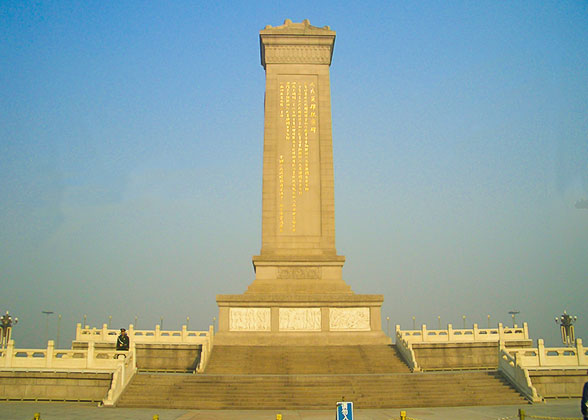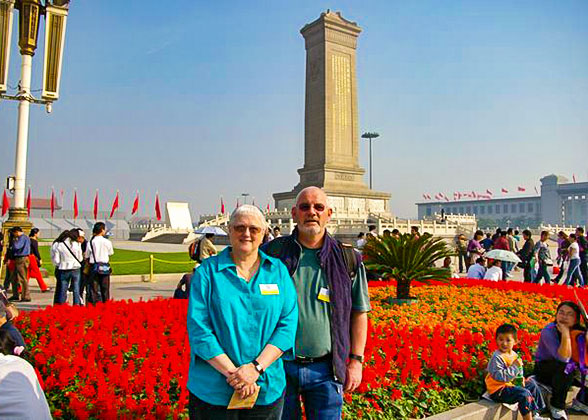Monument to the People's Heroes
The Monument to the People's Heroes stands in the center of Tiananmen Square, north of the Memorial Hall of Chairman Mao. Four hundred and sixty three meters south from Tiananmen, and four hundred and forty meters north from Zhengyangmen, Monument to People's Heroes coincides with the south-north center axis. The Monument to the People's Heroes, together with Tiananmen and Zhengyangmen form a harmonious and consistent building complex.
On September 30 of 1949, the first China People's Political Consultant Conference brought up the idea of building a monument in Beijing, capital of China, o commemorate the people's heroes in modern Chinese history. At 6 p.m. of the same day, the ground-breaking ceremony was held, in which delegates led by Mao Zedong, Chairman of the Politburo of the Communist Party of China from 1943 and the Chairman of the Central Committee of the Communist Party of China from 1945 to 1976, broke ground, laying the cornerstone of the monument. The construction of Monument to People's Heroes was started on August 1, 1952 and completed on April 22, 1958. On May 1 of 1958, the inauguration ceremony was held. In 1961, it was designated as one of China's foremost protected relics.
 The Monument to the People's Heroes is a square building, covering an area of 3,000 square meters. It is composed of three parts; the body, the Buddhist-style base, and the pedestal, reaching as tall as 37.94m. The body of Monument to People's Heroes is made up of 413 pieces of granite 32 layers deep. In the center of the north side of the monument, a single complete piece of stone, 14.7m long, 2.9m wide and 1m thick, is inscribed with large, glazed words by Mao Zedong which read: "Eternal Glory to the People's Heroes." The south side of the monument is composed of 7 pieces of stone with a draught of an epigraph by Mao Zedong and inscribed by Zhou Enlai, the first premier of the People's Republic of China who served from October 1949 until his death in January 1976. The east and west sides of the monument are carved with patterns of five-pointed stars, pine trees and flags.
The Monument to the People's Heroes is a square building, covering an area of 3,000 square meters. It is composed of three parts; the body, the Buddhist-style base, and the pedestal, reaching as tall as 37.94m. The body of Monument to People's Heroes is made up of 413 pieces of granite 32 layers deep. In the center of the north side of the monument, a single complete piece of stone, 14.7m long, 2.9m wide and 1m thick, is inscribed with large, glazed words by Mao Zedong which read: "Eternal Glory to the People's Heroes." The south side of the monument is composed of 7 pieces of stone with a draught of an epigraph by Mao Zedong and inscribed by Zhou Enlai, the first premier of the People's Republic of China who served from October 1949 until his death in January 1976. The east and west sides of the monument are carved with patterns of five-pointed stars, pine trees and flags.
The body of Monument to People's Heroes sits on two layers of Buddhist-style bases. The upper, smaller one is carved with a pattern of eight garlands made up of peony, lotus, chrysanthemum and other flowers. The larger one below is beset with ten big white marble bas-relief, eight of which reflect revolutionary events in China's modern history. In historical sequence, they are "Burning Opium in Humen", and "Jintian Uprising" on the east side, "Wuchang Uprising", "May Fourth Movement", and "May 30th Movement of 1925" on the south side, "Nanchang Movement", and "Anti-Japanese War" on the west side and "Campaign of Crossing Changjiang River on the north side (the front). "Crossing Yangtze River Campaign" also on the front, is the largest among the ten, with two decorative works "Supporting the Frontline" and "Greeting the People's Liberation Army". All of the ten bas-reliefs, featuring more than 170 figures, are 2m high, 2 to 6.4m wide and reach to a total length of 40.68m. The pedestal is divided into two layers, 50.44m from east to west and 61.5m from south to north. Both of the upper square one and lower one are surrounded with columns and steps.
The epigraph on the south side inscribed by Zhou Enlai is as follows:
Eternal glory to the heroes of the people who laid down their lives in the people's war of liberation and the people's revolution in the past three years!
Eternal glory to the heroes of the people who laid down their lives in the people's war of liberation and the people's revolution in the past thirty years!
Eternal glory to the heroes of the people who from 1840 laid down their lives in many struggles against domestic and foreign enemies for national independence, freedom and the well-being of the people!
(Note: the "past three years" refers roughly to the Chinese Liberation War (1946-1949); the "past thirty years" refers to the New Democratic Revolution from the May Fourth Movement in 1919 to the end of the revolution in 1949; and "from 1840" refers to the general struggle of the Chinese people against the various external and internal strife from the beginning of the Opium Wars to the establishment of the People's Republic of China.)
By Bus:
1. Take bus 120 or Sightseeing Bus Line 2 to Tian'anmen Squest West.
2. Take bus 2, 5, 120 or Sightseeing Bus Line 2 to Tian'anmen Square East.
3. Take bus 1, 2, 52, 59, 82, 120, Sightseeing Bus Line 2 or Tourist Bus Line 2 to Tian'anmen East.
By Subway:
1. Take Subway Line 1 to Tiananmen East Station or Tiananmen West Station and walk south.
2. Take Subway Line 2 and get off at Qianmen Station and walk north.
Beijing Bus / Subway Search
On September 30 of 1949, the first China People's Political Consultant Conference brought up the idea of building a monument in Beijing, capital of China, o commemorate the people's heroes in modern Chinese history. At 6 p.m. of the same day, the ground-breaking ceremony was held, in which delegates led by Mao Zedong, Chairman of the Politburo of the Communist Party of China from 1943 and the Chairman of the Central Committee of the Communist Party of China from 1945 to 1976, broke ground, laying the cornerstone of the monument. The construction of Monument to People's Heroes was started on August 1, 1952 and completed on April 22, 1958. On May 1 of 1958, the inauguration ceremony was held. In 1961, it was designated as one of China's foremost protected relics.

 |  |
The body of Monument to People's Heroes sits on two layers of Buddhist-style bases. The upper, smaller one is carved with a pattern of eight garlands made up of peony, lotus, chrysanthemum and other flowers. The larger one below is beset with ten big white marble bas-relief, eight of which reflect revolutionary events in China's modern history. In historical sequence, they are "Burning Opium in Humen", and "Jintian Uprising" on the east side, "Wuchang Uprising", "May Fourth Movement", and "May 30th Movement of 1925" on the south side, "Nanchang Movement", and "Anti-Japanese War" on the west side and "Campaign of Crossing Changjiang River on the north side (the front). "Crossing Yangtze River Campaign" also on the front, is the largest among the ten, with two decorative works "Supporting the Frontline" and "Greeting the People's Liberation Army". All of the ten bas-reliefs, featuring more than 170 figures, are 2m high, 2 to 6.4m wide and reach to a total length of 40.68m. The pedestal is divided into two layers, 50.44m from east to west and 61.5m from south to north. Both of the upper square one and lower one are surrounded with columns and steps.
The epigraph on the south side inscribed by Zhou Enlai is as follows:
Eternal glory to the heroes of the people who laid down their lives in the people's war of liberation and the people's revolution in the past three years!
Eternal glory to the heroes of the people who laid down their lives in the people's war of liberation and the people's revolution in the past thirty years!
Eternal glory to the heroes of the people who from 1840 laid down their lives in many struggles against domestic and foreign enemies for national independence, freedom and the well-being of the people!
(Note: the "past three years" refers roughly to the Chinese Liberation War (1946-1949); the "past thirty years" refers to the New Democratic Revolution from the May Fourth Movement in 1919 to the end of the revolution in 1949; and "from 1840" refers to the general struggle of the Chinese people against the various external and internal strife from the beginning of the Opium Wars to the establishment of the People's Republic of China.)
How to get to Monument to People's Heroes
1. Take bus 120 or Sightseeing Bus Line 2 to Tian'anmen Squest West.
2. Take bus 2, 5, 120 or Sightseeing Bus Line 2 to Tian'anmen Square East.
3. Take bus 1, 2, 52, 59, 82, 120, Sightseeing Bus Line 2 or Tourist Bus Line 2 to Tian'anmen East.
By Subway:
1. Take Subway Line 1 to Tiananmen East Station or Tiananmen West Station and walk south.
2. Take Subway Line 2 and get off at Qianmen Station and walk north.
Beijing Bus / Subway Search
Other Attractions around Tiananmen Square
- Last updated on Aug. 20, 2024 by Gabby Li -